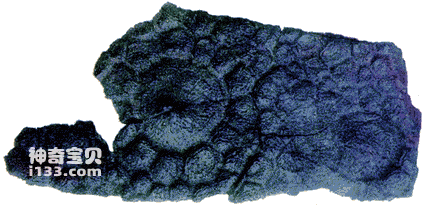In the spring of 1985, scientific and technical personnel from the Sichuan Zigong Dinosaur Museum collected a relatively complete Stegosaurus fossil skeleton from Pengtang, Zhongquan Township, a suburb of Zigong City, and numbered it "ZY-1".

Zigong dinosaur skin
In the winter of 1989, scientific and technical personnel began to repair the "ZY-1" Stegosaurus skeleton. On the shoulders of the skeleton, a pair of huge comma-shaped bone spines were found, which are called "shoulder spines". It was while trimming the left shoulder spine that Librarian Ouyang Hui accidentally discovered dinosaur skin fossils.
At that time, the technicians were concentrating on repairing the fossils, while Ouyang Hui was carefully observing the surface of the stone that had been cracked by the chisel and the rock fragments that were knocked off, hoping to find some small fossils such as plesiosaur teeth and shark scales. Suddenly, the technician chiseled away, revealing a strange flat surface with scaly patterns on the stone. Ouyang Hui picked up the collapsed rock fragments and found that there was a reverse image imprint on them. "Isn't this the skin fossil of a dinosaur!" He shouted in surprise.
It is understandable that Ouyang Hui is so excited, because it is indeed incredible that skin can form fossils. Under normal circumstances, the first condition for the formation of fossils from biological remains is that the hard parts must be preserved. Therefore, only the internal and external skeletons of animals are easiest to fossilize. But sometimes, the accidental coincidence of some natural factors can make miracles happen.
The "ZY-1" Stegosaurus fossil skeleton is exactly like this. It is not only complete, but also has good continuity. Almost all the petrified bones are connected together and preserved in the rock, vividly reflecting the last moment of its life - crawling in the mire and unable to extricate itself. This burial state indicates that the Stegosaurus was likely buried by sediments soon after falling into a river or lake and dying. When Ouyang Hui calmed down from the unexpected surprise and continued to observe, he found that the rock embedding the fossil skeleton was basically gray-green sandstone, but the small piece of preserved skin fossil was naturally purple-red mudstone. A reasonable speculation immediately emerged in Ouyang Hui's mind: when the body of this Stegosaurus was buried by the sand in rivers and lakes, a small piece of mud was mixed with it, just like a sculptor shaping a clay statue, which happened to be imprinted on it. A pattern of skin near the shoulder spine. Coincidentally, the skin of the hadrosaurus found in Alberta, Canada, was also preserved in mudstone.
You must know that the chance that ancient life can be preserved as fossils is only one in ten million, and the chance that skin marks can be preserved in fossil bones is even smaller. This can not but be said to be a natural miracle. It is through studying these rare miracles of nature that scientists have uncovered ancient mysteries one after another.
We know that dinosaurs are ancient members of the reptile family. Therefore, scientists’ inferences about their living morphology, especially their understanding of the surface morphology of their skin, are often based on living reptiles. Living reptiles such as snakes, lizards, crocodiles and other living reptiles have a cuticle layer on the outermost skin. Some are horny scales and some are horny plates. This is an effective structure that prevents the loss of body moisture and adapts to dry terrestrial environments. Did dinosaurs also have this kind of scaly skin? What does it look like?
It can be seen from this dinosaur skin fossil discovered in Zigong that Stegosaurus did have scaly skin with hexagonal horny scales on its surface. However, the size of these scales is much smaller than the scales depicted on stegosaurus ecological restoration maps or carved on stegosaurus statues in the past with reference to living reptiles.
The Zigong dinosaur skin fossils are another major discovery after the skin fossils of hadrosaurs, ceratopsians, ornithopods and carnivorous dinosaurs discovered in Canada, Mongolia, the United States and the United Kingdom. All these dinosaur skin fossils provide important clues for scientists to explore the mysteries of the Mesozoic dinosaur world.
In the UK, the skin trace fossils of an ornithopod dinosaur, Ceridosaurus, were discovered, showing that some smaller and rounded horny scales were buried in the skin surface, forming a delicate mosaic-like pattern.
In North America, scientists once discovered the "mummy" of a hadrosaurus, that is, the mummy of a hadrosaurus. It shows that the hadrosaur had very thick skin. Correspondingly, the surface of the skin fossil covering an area of 400 square centimeters in Zigong is almost parallel to the surface of the scapulohumeral body, and is filled with several centimeters of sandstone. According to general speculation, the thickness of this layer of sandstone may represent the thickness of the skin and subcutaneous muscle tissue. However, since the shoulder spine is a bony derivative of the skin like the sword plate of Stegosaurus, it is unlikely that it is too thick. muscles. It is inferred from this that the skin of Stegosaurus should also be very thick. This phenomenon is not difficult to understand, because for vegetarian dinosaurs, thick skin can undoubtedly act as a barrier against carnivorous dinosaurs to a certain extent.
animal tags:
We created this article in conjunction with AI technology, then made sure it was fact-checked and edited by a Animals Top editor.